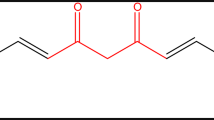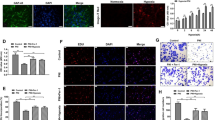Abstract
Objective
Aim of this study was to detect the expression of miR-15a in rats following chronic constriction injury (CCI) and to investigate the regulatory functions of miR-15a during neuropathic pain (NP) development.
Methods
CCI was performed in adult Sprague–Dawley rats to set up the rat model of neuropathic pain. MiR-15a agomir and scrambled control were delivered into the implanted catheter of rats. The mechanical allodynia and thermal hyperalgesia were assessed in both CCI- and sham-operated groups. Rat lumbar spinal cord tissues were harvested for mRNA and protein analyses. The primary spinal microglia were isolated from adult Sprague–Dawley rats and transfected with miR-15a mimics, scramble miRNA, miR-15a inhibitor or its corresponding negative control. Cell lysates were collected for mRNA and protein analyses.
Results
Compared to sham-operated group, the expression of miR-15a in CCI rats was significantly reduced, whereas neuroinflammation in spinal cord tissues was increased. Intrathecal administration of miR-15a agomir significantly attenuated CCI-induced NP and the levels of proinflammatory cytokines, including IL-6, IL-1β, and TNF-α. AKT3 was predicted and confirmed as a miR-15a-regulated gene. We further demonstrated that miR-15a overexpression downregulated the level of AKT3 in primary rat microglia and rat CCI model. Moreover, the upregulation of miR-15a induced the expressions of autophagy-associated proteins, suggesting that the regulation mechanism of miR-15a in NP development involves AKT3-mediated autophagy via inhibiting the expression of AKT3.
Conclusion
Our findings indicated that miR-15a might serve as a promising therapeutic target for the management of NP through the stimulation of autophagic process.




Similar content being viewed by others
Availability of data and materials
All data generated or analyzed during this study are included in this published article.
References
Andersen HH, Duroux M, Gazerani P (2014) MicroRNAs as modulators and biomarkers of inflammatory and neuropathic pain conditions. Neurobiol Dis 71:159–168
Aqeilan RI, Calin GA, Croce CM (2010) miR-15a and miR-16-1 in cancer: discovery, function and future perspectives. Cell Death Differ 17:215–220
Austin PJ, Wu A, Moalem-Taylor G (2012) Chronic constriction of the sciatic nerve and pain hypersensitivity testing in rats. J Vis Exp 61:e3393
Bartel DP (2004) MicroRNAs: genomics, biogenesis, mechanism, and function. Cell 116:281–297
Bekris LM, Lutz F, Montine TJ, Yu CE, Tsuang D, Peskind ER, Leverenz JB (2013) MicroRNA in Alzheimer’s disease: an exploratory study in brain, cerebrospinal fluid and plasma. Biomarkers 18:455–466
Bennett GJ, Xie YK (1988) A peripheral mononeuropathy in rat that produces disorders of pain sensation like those seen in man. Pain 33:87–107
Berliocchi L, Russo R, Maiaru M, Levato A, Bagetta G, Corasaniti MT (2011) Autophagy impairment in a mouse model of neuropathic pain. Mol Pain 7:83
Bjorkoy G, Lamark T, Brech A, Outzen H, Perander M, Overvatn A, Stenmark H, Johansen T (2005) p62/SQSTM1 forms protein aggregates degraded by autophagy and has a protective effect on huntingtin-induced cell death. J Cell Biol 171:603–614
Cai CK, Zhao GY, Tian LY, Liu L, Yan K, Ma YL, Ji ZW, Li XX, Han K, Gao J et al (2012) miR-15a and miR-16-1 downregulate CCND1 and induce apoptosis and cell cycle arrest in osteosarcoma. Oncol Rep 28:1764–1770
Cai W, Zhao Q, Shao J, Zhang J, Li L, Ren X, Su S, Bai Q, Li M, Chen X et al (2018) MicroRNA-182 Alleviates Neuropathic Pain by Regulating Nav1.7 Following Spared Nerve Injury in Rats. Sci Rep 8:16750
Calin GA, Dumitru CD, Shimizu M, Bichi R, Zupo S, Noch E, Aldler H, Rattan S, Keating M, Rai K et al (2002) Frequent deletions and down-regulation of micro- RNA genes miR15 and miR16 at 13q14 in chronic lymphocytic leukemia. Proc Natl Acad Sci USA 99:15524–15529
Chaplan SR, Bach FW, Pogrel JW, Chung JM, Yaksh TL (1994) Quantitative assessment of tactile allodynia in the rat paw. J Neurosci Methods 53:55–63
Chen HP, Zhou W, Kang LM, Yan H, Zhang L, Xu BH, Cai WH (2014) Intrathecal miR-96 inhibits Nav1.3 expression and alleviates neuropathic pain in rat following chronic construction injury. Neurochem Res 39:76–83
Chen H, Hu Y, Xie K, Chen Y, Wang H, Bian Y, Wang Y, Dong A, Yu Y (2018) Effect of autophagy on allodynia, hyperalgesia and astrocyte activation in a rat model of neuropathic pain. Int J Mol Med 42:2009–2019
Colloca L, Ludman T, Bouhassira D, Baron R, Dickenson AH, Yarnitsky D, Freeman R, Truini A, Attal N, Finnerup NB et al (2017) Neuropathic pain. Nat Rev Dis Primers 3:17002
Corum DG, Tsichlis PN, Muise-Helmericks RC (2014) AKT3 controls mitochondrial biogenesis and autophagy via regulation of the major nuclear export protein CRM-1. FASEB J 28:395–407
Ellis A, Bennett DL (2013) Neuroinflammation and the generation of neuropathic pain. Br J Anaesth 111:26–37
Favereaux A, Thoumine O, Bouali-Benazzouz R, Roques V, Papon MA, Salam SA, Drutel G, Leger C, Calas A, Nagy F et al (2011) Bidirectional integrative regulation of Cav1.2 calcium channel by microRNA miR-103: role in pain. EMBO J 30:3830–3841
Hargreaves K, Dubner R, Brown F, Flores C, Joris J (1988) A new and sensitive method for measuring thermal nociception in cutaneous hyperalgesia. Pain 32:77–88
Hu Y, Liu Q, Zhang M, Yan Y, Yu H, Ge L (2019) MicroRNA-362-3p attenuates motor deficit following spinal cord injury via targeting paired box gene 2. J Integr Neurosci 18:57–64
Kamalden TA, Macgregor-Das AM, Kannan SM, Dunkerly-Eyring B, Khaliddin N, Xu Z, Fusco AP, Yazib SA, Chow RC, Duh EJ et al (2017) Exosomal MicroRNA-15a transfer from the pancreas augments diabetic complications by inducing oxidative stress. Antioxid Redox Signal 27:913–930
Liu WJ, Ye L, Huang WF, Guo LJ, Xu ZG, Wu HL, Yang C, Liu HF (2016) p62 links the autophagy pathway and the ubiqutin-proteasome system upon ubiquitinated protein degradation. Cell Mol Biol Lett 21:29
Liu B, Sun T, Wu G, Shang-Guan H, Jiang ZJ, Zhang JR, Zheng YF (2017) MiR-15a suppresses hepatocarcinoma cell migration and invasion by directly targeting cMyb. Am J Transl Res 9:520–532
Luo Q, Li X, Li J, Kong X, Zhang J, Chen L, Huang Y, Fang L (2013) MiR-15a is underexpressed and inhibits the cell cycle by targeting CCNE1 in breast cancer. Int J Oncol 43:1212–1218
McCarberg BH, Billington R (2006) Consequences of neuropathic pain: quality-of-life issues and associated costs. Am J Manag Care 12:S263–268
Murnion BP (2018) Neuropathic pain: current definition and review of drug treatment. Aust Prescr 41:60–63
Murrow L, Debnath J (2013) Autophagy as a stress-response and quality-control mechanism: implications for cell injury and human disease. Annu Rev Pathol 8:105–137
Nah J, Yuan J, Jung YK (2015) Autophagy in neurodegenerative diseases: from mechanism to therapeutic approach. Mol Cells 38:381–389
National Research Council Committee for the Update of the Guide for the C, Use of Laboratory A (2011) The National Academies Collection: Reports funded by National Institutes of Health. In: th (ed) Guide for the Care and Use of Laboratory Animals. National Academies Press (US), National Academy of Sciences, Washington (DC)
Niederberger E, Kynast K, Lotsch J, Geisslinger G (2011) MicroRNAs as new players in the pain game. Pain 152:1455–1458
Okamoto K, Martin DP, Schmelzer JD, Mitsui Y, Low PA (2001) Pro- and anti-inflammatory cytokine gene expression in rat sciatic nerve chronic constriction injury model of neuropathic pain. Exp Neurol 169:386–391
Park JM, Huang S, Wu TT, Foster NR, Sinicrope FA (2013) Prognostic impact of Beclin 1, p62/sequestosome 1 and LC3 protein expression in colon carcinomas from patients receiving 5-fluorouracil as adjuvant chemotherapy. Cancer Biol Ther 14:100–107
Shi G, Shi J, Liu K, Liu N, Wang Y, Fu Z, Ding J, Jia L, Yuan W (2013) Increased miR-195 aggravates neuropathic pain by inhibiting autophagy following peripheral nerve injury. Glia 61:504–512
Shi J, Jiang K, Li Z (2018) MiR-145 ameliorates neuropathic pain via inhibiting inflammatory responses and mTOR signaling pathway by targeting Akt3 in a rat model. Neurosci Res 134:10–17
Spinetti G, Fortunato O, Caporali A, Shantikumar S, Marchetti M, Meloni M, Descamps B, Floris I, Sangalli E, Vono R et al (2013) MicroRNA-15a and microRNA-16 impair human circulating proangiogenic cell functions and are increased in the proangiogenic cells and serum of patients with critical limb ischemia. Circ Res 112:335–346
van Hecke O, Austin SK, Khan RA, Smith BH, Torrance N (2014) Neuropathic pain in the general population: a systematic review of epidemiological studies. Pain 155:654–662
Willemen HL, Eijkelkamp N, Wang H, Dantzer R, Dorn GW 2nd, Kelley KW, Heijnen CJ, Kavelaars A (2010) Microglial/macrophage GRK2 determines duration of peripheral IL-1beta-induced hyperalgesia: contribution of spinal cord CX3CR1, p38 and IL-1 signaling. Pain 150:550–560
Yaksh TL, Rudy TA (1976) Chronic catheterization of the spinal subarachnoid space. Physiol Behav 17:1031–1036
Funding
Not applicable.
Author information
Authors and Affiliations
Contributions
LXC and XFL conceived and designed the experiments, FL and QCG analyzed and interpreted the results of the experiments, QH, QZ and ZHC performed the experiments.
Corresponding author
Ethics declarations
Conflict of interest
Longxue Cai, Xianfa Liu, Qicai Guo, Qi huang, Qiong Zhang and Zuohong Cao declare that they have no conflict of interest.
Ethical approval
The animal use protocol listed below has been reviewed and approved by the Animal Ethical and Welfare Committee.
Additional information
Publisher's Note
Springer Nature remains neutral with regard to jurisdictional claims in published maps and institutional affiliations.
Rights and permissions
About this article
Cite this article
Cai, L., Liu, X., Guo, Q. et al. MiR-15a attenuates peripheral nerve injury-induced neuropathic pain by targeting AKT3 to regulate autophagy. Genes Genom 42, 77–85 (2020). https://doi.org/10.1007/s13258-019-00881-z
Received:
Accepted:
Published:
Issue Date:
DOI: https://doi.org/10.1007/s13258-019-00881-z




